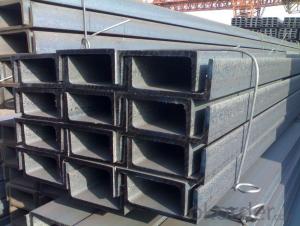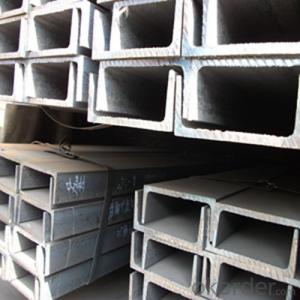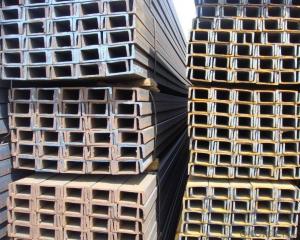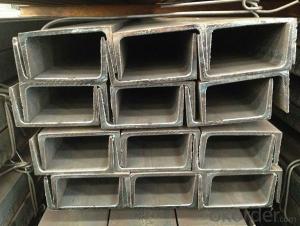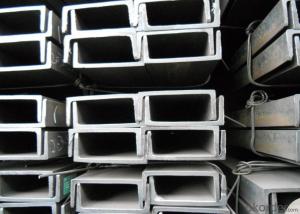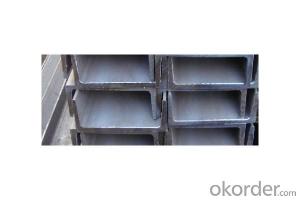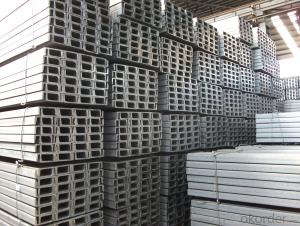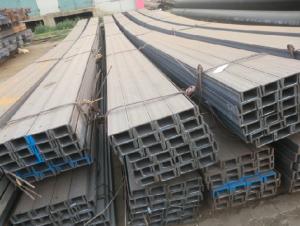Hot-rolled steel channel
- Loading Port:
- China Main Port
- Payment Terms:
- TT OR LC
- Min Order Qty:
- -
- Supply Capability:
- -
OKorder Service Pledge
OKorder Financial Service
You Might Also Like
Channel is the section groove strip steel. Channel steel is used in the construction and machinery for carbon structural steel, steel steel section is complex, its sectional shapegroove. Channel steel is mainly used for building structure, the curtain wall engineering,mechanical equipment and vehicle manufacturing etc.. Request it has better welding, rivetingperformance and comprehensive mechanical properties in use. Steel billet production raw materials are carbon content not exceeding 0.25% of the carbon steel or low alloy steel billet.Product channel steel after hot forming, normalizing or hot-rolled state of delivery. Thespecifications to waist high (H) * leg width (b) * waist thick (d) millimeter number representation, such as 100*48*5.3, said waist height 100 mm, width of 48 mm steel legs,waist thickness was 5.3 mm, or 10# channel. Waist high the same channel, if there are several different wide legs and waist thickness also need to add a B C to be the difference in the types of the right, such as 25#a 25#b 25#c etc..
Classification
Channel can be divided into ordinary steel and light channel. Hot rolled ordinary channelspecifications for 5-40#. By both sides of supply and demand supply of hot rolled flexiblechannel protocol specifications for 6.5-30#. Channel steel is mainly used for building structure, vehicle manufacturing, other industrial structure and a fixed disk cabinet, steeloften used together with choices.
Channel steel according to shape and can be divided into 4 kinds: Leng Wan equilateral channels, Leng Wan scalene channel, Leng Wan edge channel, Leng Wan channel section with outer edge
In accordance with the steel structure theory, should be the channel steel flange force, that is to say the channel should be upright, not lying.
No.
With international chemical symbols for the element and its symbols to represent the chemical composition, in Arabia letter to indicate the contents of components:
Such as: China, Russia 12CrNi3A
Using a fixed number of bits to represent the steel series digital or digital; such as: the United States, Japan, 300 series, 400 series, 200 series;
Using the Latin alphabet and their sequence number, only that the use of.
The specification set
Channel steel specifications mainly used high (H), Tui Kuan (b), waist thickness (d) and othersize
Channel steel (3)
Said that at present domestic steel specifications from 5 to 40, that is, the correspondingheight of 5 to 40cm.
At the same height, light channel than common channel steel legs, waist narrow thin, light weight. 18 - 40, 5 - 16 for large channel, channel steel for medium channel. The importchannel indicate the actual size and related standards. Steel import and export orders generally is in determining the corresponding (carbon steel or low alloy steel) steel after,required the use specifications in the main. In addition to specifications, outside the channelwithout specific composition and performance series.
The delivery channel length is divided into fixed length, double length two, and the provisions of tolerance in the corresponding standard. The domestic channel length selection scope according to the specifications of different divided into 5 12M, 5 19m, 6 19m three. The importchannel length selection is generally in the range 6 to 15m.
China's steel imports more than it exports. Simple import and along with the complete engineering importing two channels. In recent years, China's coastal big port (Dalian, Tianjin,Qinhuangdao, Lianyungang etc.) in the new, expansion of oil, coal, grain and other bulkimport and export commodity automatic loading and unloading in the project, with the mainequipment is introduced at the same time, imports large channel is on the increase. The main production countries and regions as Japan, Russia, Western europe. Export channel mainly to Hong Kong and macao.
7 the appearance requirements
Surface quality and geometry of the channel of the allowable deviation are specified in the standard. General requirement of surface shall not use harmful defects, there shall be nosignificant reverse, provisions of channel wave bending (camber) related to allow surface shape value and various specifications channel parameters (h, B, D, t etc.) numerical,tolerance. The main performance of channel geometry is not true: angle, leg extended legand etc..
8 the main origin
Channel of China is mainly composed of several steel production, steel, iron, Tang Gang,Huang te, Maanshan Iron and steel, Bao Steel, Xuanhua Steel, Japan etc..
- Q: How are steel channels protected during transportation and storage?
- To ensure the quality and prevent damage of steel channels, various measures are taken during their transportation and storage. Protective coatings or finishes, such as paint or galvanizing, are commonly used to create a barrier between the steel channels and the external environment, thereby preventing corrosion and rusting. During transportation, steel channels are securely bundled and fastened with straps or chains to prevent any movement or potential damage. They may also be placed in crates or containers to provide additional protection and avoid any impact from external forces. For storage, it is important to keep the steel channels in a dry and well-ventilated area to avoid exposure to moisture. Stacking them on pallets or racks helps to prevent direct contact with the ground and minimizes the risk of damage. Moreover, storing them in a covered area or using weatherproof covers provides further protection against precipitation and other weather elements. Regular inspections are crucial throughout transportation and storage to detect any signs of damage or deterioration. This allows for prompt repairs or replacements to be carried out, ensuring that the steel channels remain in optimal condition. In conclusion, proper protective measures, including coatings, secure bundling, appropriate storage conditions, and regular inspections, are indispensable for safeguarding steel channels during transportation and storage, thereby preserving their quality and preventing potential damage.
- Q: What are the applications of steel channels?
- Steel channels have a wide range of uses in different industries and sectors. In the construction industry, they are commonly employed as structural components in building frames, bridges, and other infrastructure projects. Steel channels offer strength, stability, and load-bearing capacity, making them suitable for supporting heavy loads and enduring environmental factors like wind, earthquakes, and extreme temperature changes. Besides construction, the manufacturing industry also extensively utilizes steel channels. They are often incorporated into the production of machinery, equipment, and vehicles. Steel channels can be employed as support structures in manufacturing plants and in the fabrication of frames, conveyors, and racks. Their high strength-to-weight ratio makes them ideal for such applications. In the renewable energy sector, steel channels play a crucial role, particularly in the construction of solar panel mounting systems and wind turbine towers. Thanks to their durability and resistance to corrosion, steel channels provide a dependable and sturdy framework for these renewable energy installations. Furthermore, the automotive industry frequently employs steel channels. They are used in the chassis and body frames of automobiles to ensure structural integrity and enhance safety. The strength and rigidity of steel channels make them vital components for maintaining vehicle stability and performance. Additionally, steel channels are utilized in the manufacturing of storage systems like shelving, racking, and warehouse systems. They provide a robust framework for organizing and storing products in various commercial and industrial settings. Overall, the applications of steel channels are vast and diverse, spanning from construction and manufacturing to renewable energy and automotive industries. Their strength, durability, and versatility make them indispensable components in numerous sectors, contributing to the development of robust and reliable structures and equipment.
- Q: When building a high building, in order to take scaffolding, the channel into the wall, support scaffolding, etc., after the completion of scaffolding dismantled, channel after taking out, although the hole will be filled well, but the building will not leak it? The building I bought a total of 32 layers, wherein the 9 layer, 17 layer, 25 layer into the channel, I bought 17 layers, the future will Water Leakage ah, good fear, a knowledgeable friend to help answer,...
- The facade is usually not waterproof, because it does not soak in water.
- Q: How do steel channels contribute to the overall energy efficiency of a structure?
- There are several ways in which steel channels can enhance the overall energy efficiency of a structure. To begin with, steel channels are frequently utilized in the construction of walls and roofs, providing structural support and evenly distributing the building's weight. By incorporating steel channels, the structure's overall weight can be reduced, resulting in lower energy consumption during construction and throughout the lifespan of the building. Moreover, it is possible to design steel channels in a manner that imparts insulation properties. Thermal bridging, which involves the transfer of heat through materials with high thermal conductivity, is a common issue in buildings. However, by engineering steel channels to minimize thermal bridging through the inclusion of insulation materials or thermal breaks, the transfer of heat between the building's interior and exterior can be reduced, thereby improving energy efficiency. Furthermore, steel channels are renowned for their strength and durability. This enables the construction of larger spans and open spaces, eliminating the need for additional support columns or walls. By maximizing the utilization of open areas, natural light and ventilation can be optimized, reducing reliance on artificial lighting and mechanical HVAC systems. This not only decreases energy consumption but also enhances the comfort and well-being of occupants. Lastly, one advantage of steel channels is their recyclability. Steel is one of the most recycled materials globally, and incorporating recycled steel channels into construction projects can significantly diminish the environmental impact. The energy required to produce recycled steel is considerably lower compared to the production of virgin steel, further contributing to the overall energy efficiency of the structure. In conclusion, steel channels play a crucial role in enhancing the overall energy efficiency of structures by reducing weight, minimizing thermal bridging, enabling open spaces for natural lighting and ventilation, and being recyclable. By incorporating steel channels into construction, buildings can achieve superior energy performance, reducing energy consumption, and promoting sustainability.
- Q: Can steel channels be used in outdoor environments?
- Yes, steel channels can be used in outdoor environments. Steel is a durable and weather-resistant material, making it suitable for various outdoor applications such as construction, infrastructure, and outdoor structures. It can withstand harsh weather conditions, including rain, snow, and extreme temperatures, without rusting or deteriorating easily. Additionally, steel channels can be galvanized or coated with protective coatings to enhance their resistance to corrosion and extend their lifespan in outdoor environments.
- Q: Can steel channels be used in mezzanine floors?
- Yes, steel channels can be used in mezzanine floors. Steel channels are commonly used as structural elements in mezzanine construction to provide support and stability. They are strong and durable, making them suitable for supporting heavy loads and ensuring the safety and stability of the mezzanine floor.
- Q: Can steel channels be used in cold storage facilities?
- Yes, steel channels can be used in cold storage facilities. Steel is a strong and durable material that can withstand the low temperatures and provide structural support for the storage facility. It is commonly used in the construction of cold storage buildings due to its resistance to corrosion and ability to maintain stability in cold environments.
- Q: How do steel channels contribute to the overall cost-effectiveness of a project?
- There are numerous ways in which steel channels enhance the cost-effectiveness of a project. To begin with, their durability and strength ensure a longer lifespan compared to alternative materials. Consequently, maintenance and replacement costs are reduced over time, resulting in long-term savings. Furthermore, steel channels are both lightweight and robust, making them more convenient and cost-effective to transport and handle during construction. This diminishes labor and transportation expenses, as well as the necessity for heavy machinery, ultimately contributing to overall cost savings. Moreover, steel channels possess versatility and can be easily fabricated to meet specific project requirements. Their adaptability allows for efficient customization, minimizing waste and lowering material costs. Additionally, steel channels exhibit excellent corrosion resistance, reducing the need for regular maintenance and extending their lifespan, thereby generating further cost savings. Additionally, steel channels are often manufactured using recycled steel, which is not only environmentally friendly but also cost-effective. By utilizing recycled materials, the overall production cost can be reduced, rendering steel channels a more affordable option for construction projects. Lastly, steel channels offer a high strength-to-weight ratio, meaning that fewer materials are necessary to achieve the same structural integrity compared to other materials. This leads to cost savings in terms of material procurement and construction time, as less material needs to be installed. In conclusion, steel channels contribute to the overall cost-effectiveness of a project through their durability, lightweight properties, adaptability, corrosion resistance, and potential for utilizing recycled materials. By considering these factors, the use of steel channels in construction projects can result in significant cost savings, making them a cost-effective choice for various applications.
- Q: What are the different types of connections for steel channels in modular office systems?
- There are several different types of connections that can be used for steel channels in modular office systems. These connections are designed to provide stability and structural integrity to the overall system. One common type of connection is the bolted connection. This involves using bolts to secure the steel channels together. The bolts are typically inserted through pre-drilled holes in the channels and then tightened with nuts. Bolted connections are relatively easy to install and provide a strong and reliable connection. Another type of connection is the welded connection. This involves joining the steel channels together by melting the metal at the connection points and allowing it to solidify. Welded connections are highly durable and provide excellent strength. However, they require skilled labor and specialized equipment to be properly executed. A third type of connection is the riveted connection. This involves using rivets to secure the steel channels together. Rivets are typically inserted through pre-drilled holes in the channels and then deformed to hold them in place. Riveted connections are known for their high load-carrying capacity and resistance to vibration. However, they can be more time-consuming to install compared to bolted connections. Additionally, there are also adhesive connections that utilize high-strength adhesives to bond the steel channels together. This type of connection is often used in conjunction with other connection methods to provide additional stability. Adhesive connections are particularly useful in situations where drilling or welding is not feasible or desirable. In summary, the different types of connections for steel channels in modular office systems include bolted connections, welded connections, riveted connections, and adhesive connections. Each type has its own advantages and considerations, and the choice of connection method will depend on factors such as load requirements, installation limitations, and budget constraints.
- Q: How are steel channels used in structural applications?
- Steel channels are widely used in structural applications due to their excellent strength and versatility. They are commonly used in the construction industry for supporting heavy loads and providing structural integrity to buildings, bridges, and other infrastructures. One of the main applications of steel channels is in the framing of buildings. They are often used as beams or columns to support the weight of floors, walls, and roofs. Steel channels are chosen for these applications because they can withstand a significant amount of load without deforming or collapsing. In addition to building frames, steel channels are also used for bracing and reinforcing structures. They can be used as diagonal braces to provide lateral stability and prevent the structure from swaying or collapsing under wind or seismic forces. Steel channels are also utilized as reinforcement in concrete structures, such as retaining walls and foundations, to enhance their strength and durability. Steel channels are also employed in the manufacturing of machinery and equipment. They provide a stable and rigid framework for heavy machinery, allowing them to operate smoothly and efficiently. In this context, steel channels are often used as support beams, frames, or structural components in various industrial applications. Furthermore, steel channels find application in the transportation industry. They are used in the construction of bridges and overpasses, where their high strength and load-bearing capacity are essential for safely carrying vehicles and pedestrians. Steel channels are also utilized in the manufacturing of railway tracks and tramways, providing a durable and stable foundation for the transportation system. Overall, steel channels play a crucial role in structural applications by providing strength, stability, and durability to various types of constructions. Their versatility and ability to withstand heavy loads make them a preferred choice in the construction, manufacturing, and transportation industries.
Send your message to us
Hot-rolled steel channel
- Loading Port:
- China Main Port
- Payment Terms:
- TT OR LC
- Min Order Qty:
- -
- Supply Capability:
- -
OKorder Service Pledge
OKorder Financial Service
Similar products
Hot products
Hot Searches
Related keywords
